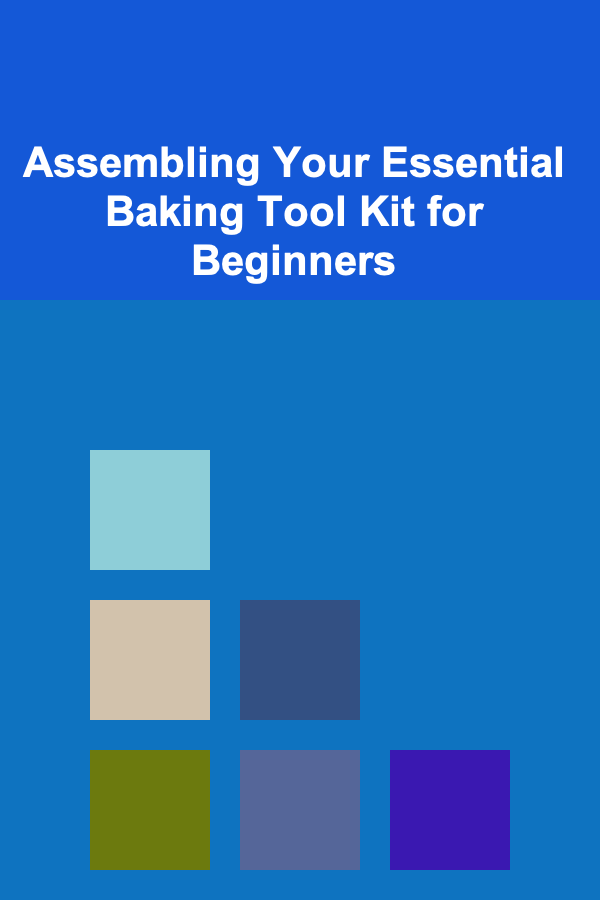
Assembling Your Essential Baking Tool Kit for Beginners
ebook include PDF & Audio bundle (Micro Guide)
$12.99$7.99
Limited Time Offer! Order within the next:

Embarking on the journey of baking can be incredibly rewarding, filling your home with delightful aromas and allowing you to create delicious treats. However, stepping into the world of baking can also feel overwhelming, especially when faced with the vast array of tools and equipment available. This comprehensive guide aims to demystify the process by outlining the essential baking tools every beginner needs, focusing on functionality, versatility, and affordability. We'll delve into why each tool is important, what features to look for, and offer recommendations to help you build a well-rounded and effective baking tool kit without breaking the bank.
The Foundation: Measuring Tools
Precise measurements are paramount in baking. Unlike cooking, where improvisation is often encouraged, baking relies on the chemical reactions between ingredients to achieve the desired outcome. Accurate measurements ensure consistency in your results, preventing disasters like flat cookies or dense cakes.
Measuring Cups (Dry)
Dry measuring cups are specifically designed for measuring ingredients like flour, sugar, and oats. They come in nested sets, typically including 1 cup, ½ cup, ⅓ cup, and ¼ cup measures. Look for sets made of stainless steel or durable plastic. Stainless steel is generally more durable and easier to clean, while plastic options are often more affordable. Ensure the cups have a level rim so you can easily scrape off excess ingredient for accurate measurements.
Why they're essential: Accurate measurement of dry ingredients is fundamental to baking success.
Measuring Spoons
Similar to dry measuring cups, measuring spoons are designed for measuring small amounts of dry and liquid ingredients like spices, baking powder, and vanilla extract. A standard set usually includes 1 tablespoon, 1 teaspoon, ½ teaspoon, and ¼ teaspoon measures. Again, stainless steel is a good choice for durability, but plastic options are perfectly adequate for beginners. Choose spoons that are clearly marked and easy to read.
Why they're essential: Precise measurement of small quantities of ingredients is crucial for flavor balance and proper leavening.
Liquid Measuring Cups
Liquid measuring cups are designed to measure liquids accurately. They are typically made of clear glass or plastic and have markings on the side to indicate volume. Look for a cup with a pouring spout for easy transfer of liquids and a sturdy base to prevent spills. A 1-cup or 2-cup liquid measuring cup is a good starting point.
Why they're essential: Measuring liquids by volume in a specifically designed cup ensures accuracy and prevents inaccurate measurements that can occur when using dry measuring cups.
Kitchen Scale
While measuring cups and spoons are a good starting point, a kitchen scale provides the most accurate way to measure ingredients. Baking by weight is often preferred by experienced bakers because it eliminates variations caused by differences in how ingredients are packed into measuring cups. A digital kitchen scale with a tare function (allowing you to zero out the weight of the container) is highly recommended.
Why it's essential (eventually): A kitchen scale allows for the most accurate and consistent results, and it's especially beneficial for recipes that require precise measurements.
Tip: Invest in a good quality kitchen scale early on. It will significantly improve the accuracy and consistency of your baking. Look for a scale that measures in both grams and ounces.
Mixing and Preparation: Essential Tools
Once you have your ingredients measured, you'll need tools to mix them effectively and prepare them for baking. These tools will help you create smooth batters, properly incorporate ingredients, and prep your baking pans.
Mixing Bowls
A set of mixing bowls in varying sizes is essential. Choose bowls made of stainless steel, glass, or sturdy plastic. Stainless steel bowls are durable, easy to clean, and don't react with acidic ingredients. Glass bowls are also easy to clean and allow you to see the mixture from all angles. Plastic bowls are lightweight and often more affordable, but they can stain and retain odors over time. A set with at least three bowls (small, medium, and large) is a good starting point.
Why they're essential: Mixing bowls provide a dedicated space for combining ingredients and offer versatility for various baking tasks.
Wooden Spoons
Wooden spoons are versatile and gentle on your cookware. They're ideal for stirring batters, creaming butter and sugar, and folding in delicate ingredients. Choose wooden spoons made of hardwood like beech or maple, as they are more durable and less likely to splinter. Avoid spoons with rough edges or splinters.
Why they're essential: Wooden spoons are gentle, versatile, and don't conduct heat like metal spoons, making them ideal for various baking tasks.
Rubber Spatulas
Rubber spatulas (also called silicone spatulas) are essential for scraping bowls clean, folding in ingredients, and spreading frosting. Look for spatulas with heat-resistant silicone heads and comfortable handles. A set with different sizes and shapes is helpful for various tasks.
Why they're essential: Rubber spatulas are perfect for scraping every last bit of batter from bowls and ensuring even distribution of ingredients.
Whisk
A whisk is used to incorporate air into mixtures, creating light and fluffy results. It's essential for whipping cream, beating eggs, and combining dry ingredients. Choose a whisk with sturdy wires and a comfortable handle. A balloon whisk is a good all-around option.
Why they're essential: A whisk is crucial for incorporating air into batters and creams, resulting in lighter and fluffier baked goods.
Sifter
While not strictly essential for every recipe, a sifter is helpful for removing lumps from dry ingredients like flour, cocoa powder, and powdered sugar. Sifting also aerates the ingredients, making them lighter and easier to incorporate. You can choose a hand-crank sifter or a mesh sieve.
Why it's helpful: Sifting ensures a smoother batter and lighter texture by removing lumps and aerating dry ingredients.
Pastry Brush
A pastry brush is used to brush melted butter onto dough, glaze pastries, and grease baking pans. Choose a pastry brush with natural bristles or silicone bristles. Silicone bristles are more hygienic and easier to clean, but natural bristles tend to hold more liquid.
Why it's helpful: A pastry brush allows for even application of liquids to baked goods, ensuring consistent browning and flavor.
Baking Pans: The Vessels of Your Creations
The right baking pans are crucial for achieving perfectly baked goods. Different pan materials and shapes will affect the baking time and the final texture of your treats.
Baking Sheets (Cookie Sheets)
Baking sheets are flat, rectangular pans used for baking cookies, biscuits, and other flat baked goods. Choose baking sheets made of aluminum or insulated aluminum. Aluminum baking sheets heat up quickly and evenly, while insulated baking sheets prevent cookies from burning on the bottom. Look for baking sheets with a slight rim to prevent ingredients from sliding off.
Why they're essential: Baking sheets provide a flat, even surface for baking cookies and other flat baked goods.
Cake Pans
A variety of cake pans are available, but a 9-inch round cake pan and a 9x13-inch rectangular cake pan are good starting points. Choose cake pans made of aluminum or nonstick material. Aluminum cake pans heat up quickly and evenly, while nonstick cake pans make it easier to release cakes without sticking. For layered cakes, two 9-inch round pans are ideal.
Why they're essential: Cake pans provide the shape and structure for baking cakes, allowing them to rise evenly and bake properly.
Muffin Tin
A muffin tin is essential for baking muffins, cupcakes, and other individual treats. Choose a muffin tin with standard-sized cups made of aluminum or nonstick material. A 12-cup muffin tin is a good all-around option.
Why it's essential: Muffin tins provide individual molds for baking muffins and cupcakes, ensuring even baking and consistent portion sizes.
Loaf Pan
A loaf pan is used for baking bread, quick breads, and meatloaf. A standard 9x5 inch loaf pan is a versatile option. Choose a loaf pan made of aluminum, nonstick material, or glass. Glass loaf pans allow you to monitor the browning of the bread, while aluminum and nonstick loaf pans are easier to release bread from.
Why it's helpful: A loaf pan provides the shape and structure for baking bread and quick breads.
Pie Plate
A pie plate is used for baking pies. Choose a pie plate made of glass, ceramic, or metal. Glass pie plates allow you to monitor the browning of the crust, while ceramic pie plates retain heat well and help prevent soggy bottoms. Metal pie plates heat up quickly and evenly.
Why it's helpful: A pie plate provides the shape and structure for baking pies, ensuring even baking and a crisp crust.
Tip: Consider investing in parchment paper or silicone baking mats to line your baking sheets and cake pans. This prevents sticking and makes cleanup much easier.
Finishing Touches: Cutting, Cooling, and Decorating
Once your baked goods are out of the oven, you'll need tools to cool them, cut them, and decorate them.
Cooling Rack
A cooling rack allows air to circulate around baked goods, preventing them from becoming soggy. Choose a cooling rack with a sturdy wire grid and a stable base. Make sure the grid is fine enough to prevent smaller baked goods from falling through.
Why it's essential: A cooling rack allows baked goods to cool evenly and prevents condensation from forming on the bottom, resulting in a crispier texture.
Serrated Knife (Bread Knife)
A serrated knife is essential for slicing bread and cakes without tearing them. Choose a serrated knife with a long blade and a comfortable handle.
Why it's helpful: A serrated knife provides clean slices through breads and cakes without crushing or tearing them.
Offset Spatula
An offset spatula is a flat spatula with a bent blade, making it ideal for frosting cakes and spreading fillings evenly. Choose an offset spatula with a stainless steel blade and a comfortable handle.
Why it's helpful: An offset spatula allows for smooth and even frosting application on cakes and cupcakes.
Piping Bags and Tips (Optional)
Piping bags and tips are used for decorating cakes and cupcakes with frosting. You can choose disposable piping bags or reusable piping bags. A set of piping tips with various shapes and sizes will allow you to create different designs.
Why they're helpful (for decorating): Piping bags and tips allow for precise and creative decorating of cakes and cupcakes.
Additional Tools to Consider
While the tools listed above are essential for beginners, the following tools can be helpful as you become more experienced in baking:
- Rolling Pin: For rolling out dough for pies, cookies, and pastries.
- Pastry Blender: For cutting butter into flour when making pie crust.
- Citrus Zester/Microplane: For grating citrus zest, chocolate, and spices.
- Cookie Cutters: For creating fun and festive cookie shapes.
- Candy Thermometer: For making candy and frosting that require precise temperatures.
Building Your Baking Toolkit on a Budget
Building a baking tool kit doesn't have to be expensive. Here are some tips for saving money:
- Start with the essentials: Focus on purchasing the most essential tools first and gradually add more specialized tools as you need them.
- Shop around: Compare prices at different stores and online retailers.
- Look for sales and discounts: Take advantage of sales, coupons, and clearance items.
- Consider used equipment: You can often find good quality used baking tools at thrift stores and garage sales.
- Buy sets: Purchasing tools in sets can often be more cost-effective than buying them individually.
Care and Maintenance of Your Baking Tools
Proper care and maintenance will help extend the life of your baking tools.
- Wash tools thoroughly after each use: Use warm, soapy water and a soft sponge. Avoid abrasive cleaners that can scratch or damage your tools.
- Dry tools completely before storing: This prevents rust and corrosion.
- Store tools in a dry, organized place: Keep your tools in a drawer, cabinet, or on a shelf where they are easily accessible and protected from damage.
- Follow manufacturer's instructions: Refer to the manufacturer's instructions for specific care and maintenance recommendations.
Conclusion
Assembling your essential baking tool kit is an exciting first step towards a world of delicious possibilities. By focusing on the fundamental tools outlined in this guide, you can confidently begin your baking journey, creating everything from simple cookies to elaborate cakes. Remember to prioritize quality over quantity, choose tools that feel comfortable in your hands, and don't be afraid to experiment and learn along the way. Happy baking!

How to DIY Cheap Decorations for Your Room on a Tight Budget
Read More
How to Plan a Stress-Free Dinner Party at Home
Read More
How to Select Energy-Efficient Bulbs for Your Home
Read More
How to Stage Your Home for a Fast Sale in a Slow Market
Read More
Standout Customer Service: Strategies for Building Loyalty and Referrals
Read More
How to Understand the History of Spaceflight
Read MoreOther Products

How to DIY Cheap Decorations for Your Room on a Tight Budget
Read More
How to Plan a Stress-Free Dinner Party at Home
Read More
How to Select Energy-Efficient Bulbs for Your Home
Read More
How to Stage Your Home for a Fast Sale in a Slow Market
Read More
Standout Customer Service: Strategies for Building Loyalty and Referrals
Read More